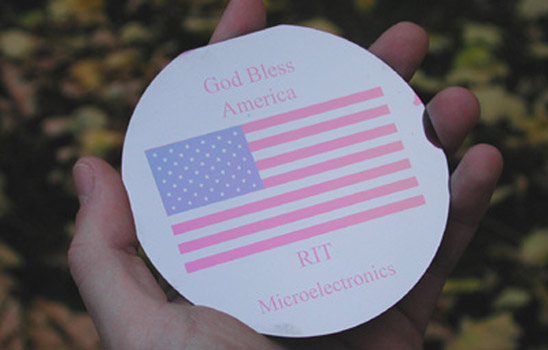RIT Engineering Students Make Patriotic Computer Wafers
A silicon wafer with an etching of the American flag created by RIT microelectronic engineering majors.
In the aftermath of the Sept. 11 terrorist attacks on the United States, students studying microelectronic engineering in Rochester Institute of Technology’s Kate Gleason College of Engineering wanted to show their patriotism. So, they did it the only way they know how, in a high-tech way.
Led by Keith Tabakman, vice president of RIT’s microelectronic engineering student association, and advisor Santosh Kurinec, professor and department head, students used a painstaking process to etch color images of the American flag onto several silicon wafers.
Here’s how they did it: images of the American flag, along with the phrase, "God Bless America," were patterned on oxidized silicon wafers in the same technique used to make integrated circuits in silicon, the most common kind of semiconductor.
When silicon is oxidized in the presence of oxygen or steam, it forms a high quality layer of silicon dioxide that, depending on its thickness, has a characteristic color when viewed under white light. Students calculated the required thicknesses that would result in the appearance of blue and red and developed a process to create those thicknesses.
Complicating matters, creating different oxide thicknesses on a single silicon substrate requires photolithography. So, the team first created silicon dioxide on the entire wafer. Then, after performing photolithography, oxide was retained in the blue region and removed elsewhere. Next, oxide was "regrown" to a specified thickness on the bare silicon. Finally, using photolithography, oxide was etched off creating white stripes and symbols of stars.
"Developing the right oxidation ‘recipes’ for the right colors required a lot of time," Kurinec says, adding that the endeavor was not only educational and patriotic for students, it also brought them together. "We all felt united," she says.
"We learned a lot," Tabakman says. "I’m very happy with the result."
Note: Digital image available. Send request to mjsuns@rit.edu.
Note: According to a national survey by U.S. News & World Report, RIT’s Kate Gleason College of Engineering ranks fourth in the nation among undergraduate and graduate engineering programs, offering degrees in computer, electrical, industrial and systems, mechanical, and microelectronic engineering, applied statistics and engineering science. RIT was the first university to offer undergraduate degrees in microelectronic and software engineering.
Founded in 1829, RIT has one of the nation’s oldest and largest cooperative education programs. The engineering college is named for Kate Gleason, the first female bank president in the United States and daughter of William Gleason, founder of what became Rochester-based Gleason Corp. Kate Gleason was America’s first woman engineering student and the first woman elected a member of the American Society of Mechanical Engineers.







